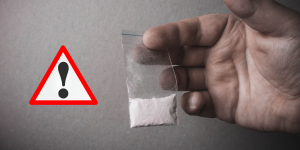
 DRUG ALERT
DRUG ALERT  – High and variable dose MDMA tablets – Pink irregular shape
– High and variable dose MDMA tablets – Pink irregular shape
High dose MDMA tablets have been found in NSW, average dose 196mg Know the risks You…
Amphetamine (short for alpha-methylphenethylamine) is a stimulant drug used to treat attention deficit hyperactivity disorder (ADHD), narcolepsy, and binge eating.1-3 Pharmaceutical amphetamine is also given to people without a prescription for non-medical use, which is called diversion.4,5 Diverted or illegally manufactured amphetamine is used as a study aid, recreationally, or by people wanting to stay awake (e.g. shift workers). 1,2 The majority of amphetamine diversion occurs when people with a prescription give or sell their amphetamine to a peer or family member, which is commonly a student seeking to improve their cognitive abilities or academic performance. 4,5 However, there is little evidence amphetamine can improve cognition in people who don’t have ADHD.6
Amphetamine was discovered in the early 20th century and was initially marketed for a range of disorders.7 It was also used as an “energy pill” during the second world war where approximately 150 million amphetamine tablets were supplied to British and American soldiers.7 In 1937, the American physician Charles Bradley noticed a beneficial effect of amphetamine in treating children who would now be diagnosed with ADHD.7 Alongside methylphenidate (Ritalin/Concerta), amphetamine is still widely used to treat ADHD, especially in adults.7

Chemically, amphetamine is two different molecules which are mirror images of each other (called enantiomers): dextroamphetamine (a.k.a. dexamphetamine or dexies) and levoamphetamine.1,2 The term “amphetamine” is used to refer to dextroamphetamine, levoamphetamine, or any mixture of the two.1 The term “amphetamines” can also refer to the class of drugs related to amphetamine, which includes MDMA and cathinones.
Amphetamine works by triggering the release of dopamine, norepinephrine, and (to a lesser extent) serotonin in the brain and it is mostly taken orally, but can also be snorted or injected.7 Dextroamphetamine is more potent than levoamphetamine and causes the release of more dopamine in the brain.7 Dextroamphetamine is sold on its own (sometimes under the name Dexedrine), or in a 3:1 combination with levoamphetamine (sold under the brand name Adderall).7,8 Despite levoamphetamine being less potent, the 3:1 in Adderall actually makes the dopamine-releasing effects last longer.7 Recently, chemists developed a modified version of dextroamphetamine called lisdexamfetamine (Vyvanse).7 Lisdexamfetamine is slowly converted into dextroamphetamine in the blood, thus making it a slow-release form of dextroamphetamine.7
Amphetamine is sometimes bought from dealers as pills, in powdered form or as “speed”. 1 Drugs bought from the dealers, including pills, can contain inaccurate doses, adulterants or other drugs entirely. If you suspect your amphetamine contains adulterants, consider taking it to a drug checking service such as CanTEST.
Stimulants can put a lot of strain on the heart, so people with existing heart conditions should avoid amphetamine.
The exact effects of drugs can vary from person to person. People with ADHD tend to respond differently to amphetamine than people without ADHD.6 Some people without ADHD take amphetamine believing it improves their cognitive abilities (e.g. memory, intelligence, focus, academic performance), however there is little evidence for this.6 The research suggests that amphetamine mainly improves cognitive abilities in people with ADHD who already have deficits in some areas.6
Generally, the effects people experience when taking amphetamine can include:1,2,8
The effects of oral amphetamine can take up to 45 minutes to kick in and typically last 2-4 hours. The effects of extended-release formulations, such as Adderall XR, can last 6-10 hours.8 Snorting amphetamine tends to make the effects kick in and wear off quicker.1,2 Lisdexamfetamine can take a long time to kick in (up to 1.5 hours) and the effects can last up to 13 hours.9 Some people experience after-effects such as anxiety, restlessness or a “hangover” feeling lasting several hours.1,2
People can react differently to drugs due to differences in bodyweight, metabolism, and other factors. It is always better to start with a low dose and wait before redosing drugs (start low and go slow).
The following is a rough dosage guide for amphetamine:2,8,10
LOW DOSE – 5-10 mg
MODERATE DOSE – 10-25 mg
STRONG DOSE – 25-40 mg
HEAVY, POSSIBLE OVERDOSE – 40+ mg
Doses exceeding 40 mg are generally not recommended, even for people with ADHD.8,10
The symptoms of an amphetamine overdose can include:6,11
Severe complications of amphetamine overdose can include:6,11
If someone is experiencing chest pain, severe lightheadedness, nausea and/or shortness of breath, seek emergency medical attention as soon as possible and stay with them until they recover.12
Suddenly stopping frequent amphetamine use can lead to withdrawal symptoms, which can include:13
The severity of symptoms and how long they last can vary from person to person.13 Most symptoms last around 7 days, but some (such as poor sleep and mood swings) can persist for a month or longer.13
If you are experiencing amphetamine withdrawal or are concerned, consider seeing a non-judgmental health professional like at the CAHMA clinic.
[1] https://wiki.tripsit.me/wiki/Amphetamine
[2] https://psychonautwiki.org/wiki/Amphetamine
[3] https://www.healthline.com/health/adhd/medication-list#stimulants
[4] https://doi.org/10.1111/j.1360-0443.2011.03720.x
[5] https://doi.org/10.1016/j.drugalcdep.2018.02.010
[6] https://doi.org/10.1002/brb3.78
[7] https://doi.org/10.1177/0269881113482532
[8] https://wiki.tripsit.me/wiki/Adderall
[9] https://www.drugs.com/medical-answers/vyvanse-start-working-long-3542596/
[10] https://www.drugs.com/dosage/dextroamphetamine.html
[11] https://www.ncbi.nlm.nih.gov/books/NBK470276/
[12] https://www.healthdirect.gov.au/heart-attack
Written by Darcy Lynch

 DRUG ALERT
DRUG ALERT  – High and variable dose MDMA tablets – Pink irregular shape
– High and variable dose MDMA tablets – Pink irregular shapeHigh dose MDMA tablets have been found in NSW, average dose 196mg Know the risks You…

About DXM DXM or dextromethorphan is an over-the-counter cough suppressant commonly sold at pharmacies. DXM acts as a dissociative drug…

 DRUG ALERT
DRUG ALERT  – Novel synthetic opioid being sold as ketamine
– Novel synthetic opioid being sold as ketamineProtonitazene is a novel synthetic opioid Opioids are central nervous system depressants. They typically produce a range of effects including sedation,…